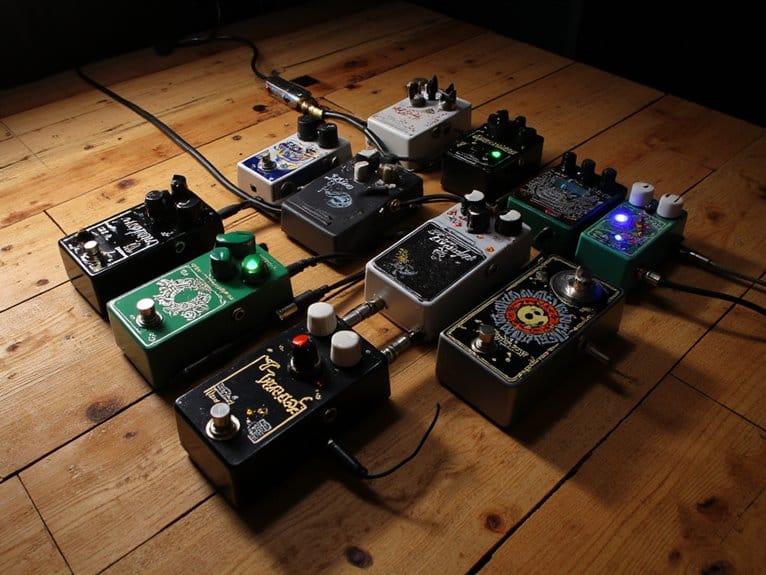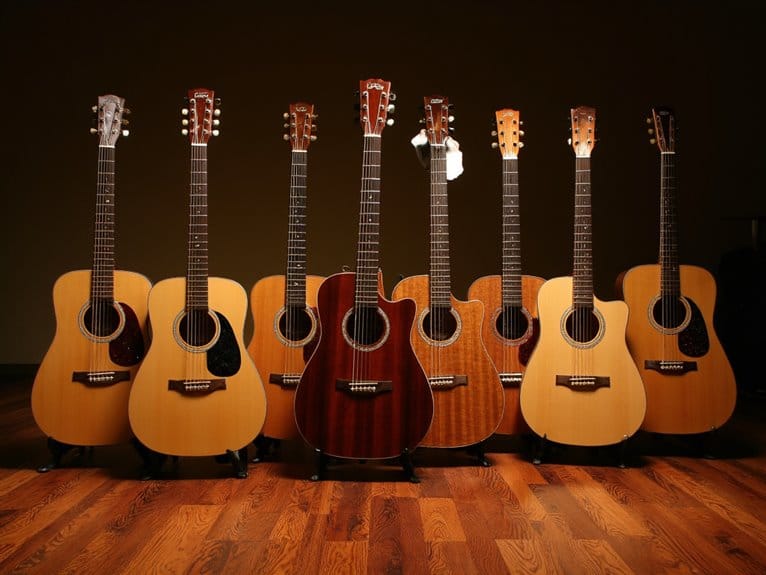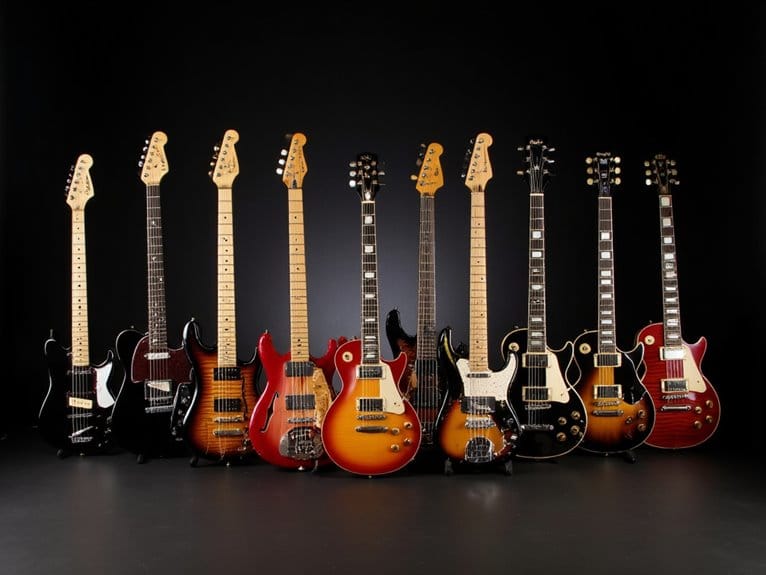Best Tuner Pedals for Perfect Pitch Every Time
After testing dozens of tuner pedals across studio and stage environments, I’ve found the Boss TU-3 delivers exceptional accuracy with fast note recognition, while the Peterson StroboStomp HD offers superior strobe technology for professional precision. Budget-conscious musicians will appreciate the Behringer TU300‘s seven tuning modes, and the MOOER Baby Tuner provides compact reliability with true bypass circuitry. Each pedal addresses specific needs, from the Donner DT-1’s strobe-mode precision to extensive feature sets that’ll transform your tuning experience.
We are supported by our audience. When you purchase through links on our site, we may earn an affiliate commission, at no extra cost for you. Learn more.
Notable Insights
- High-precision tuners like Peterson StroboStomp HD and Boss TU-3 offer ±1 cent accuracy or better for professional-grade tuning.
- Strobe tuning modes provide faster, more precise feedback than traditional needle displays for quick stage adjustments.
- True bypass functionality preserves signal integrity while metal construction ensures durability for long-term professional use.
- Bright LED displays with adjustable brightness settings maintain visibility under stage lighting and outdoor performance conditions.
- Versatile features like mute functions, calibration flexibility (436-445Hz), and low-note recognition accommodate various instruments and playing styles.
MOOER Baby Tuner Guitar Pedal with Mute Function
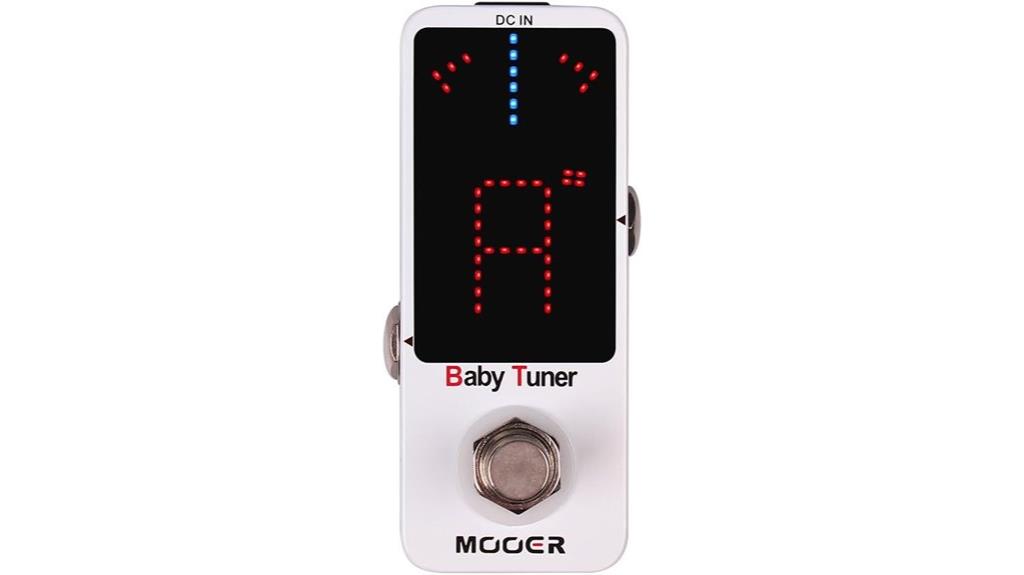
While many guitarists prioritize flashy effects pedals, the MOOER Baby Tuner Guitar Pedal with Mute Function proves that sometimes the most essential tools deserve equal attention, especially when you’re dealing with frequent tuning adjustments during live performances or studio sessions. This compact 2.8 x 2.4 x 4.72-inch metal pedal delivers reliable chromatic tuning for both electric and electro-acoustic instruments, featuring true bypass circuitry that eliminates signal interference when inactive. The mute function completely silences your signal during tuning, which I’ve found particularly valuable during band practice sessions. While it lacks the ±0.02 cent precision of premium models like the Polytune Mini, its 4.5-star rating reflects solid everyday performance for most applications.
Best For: Guitarists and bass players who need a reliable, compact tuning pedal with mute functionality for live performances and studio sessions where quick, silent tuning adjustments are essential.
Pros:
- True bypass circuitry ensures no signal interference when inactive, maintaining your tone quality
- Complete muting during tuning eliminates unwanted noise during live performances and band practice
- Compact 2.8 x 2.4 x 4.72-inch metal construction saves pedalboard space while providing durability
Cons:
- Occasional unresponsiveness issues requiring reset by unplugging the power source
- Lacks the high-precision tuning accuracy of premium competitors like the Polytune Mini (±0.02 cent)
- Performance reliability can be compromised in cold weather conditions
Boss TU-3 Chromatic Tuner Pedal with Bypass
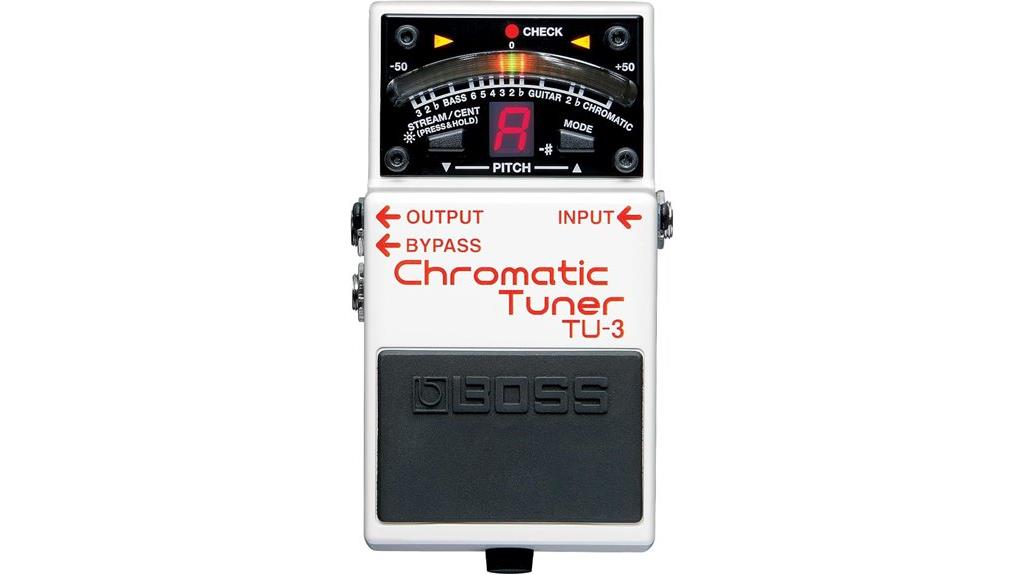
Musicians seeking rock-solid reliability in demanding stage environments will find the Boss TU-3 Chromatic Tuner Pedal delivers professional-grade accuracy that’s built to withstand the rigors of live performance. You’ll appreciate the blazing-fast note recognition that handles everything from low B strings on seven-string guitars to five-string basses with impressive +/- one cent precision. The 21-segment LED meter features adjustable brightness and a High-Brightness mode that cuts through outdoor glare, while the Accu-Pitch Sign provides instant visual confirmation when you’re perfectly in tune. What sets this pedal apart is its automatic mute function and drop tuning support down to six semitones.
Best For: Musicians who need professional-grade tuning accuracy in live performance settings and want a reliable, roadworthy pedal that can handle extended gigging with fast note recognition across multiple instrument types.
Pros:
- Exceptional accuracy (+/- one cent) with blazing-fast note recognition for guitars and basses, including 7-string guitars and 5-string basses
- High-brightness LED display with adjustable brightness cuts through outdoor glare and stage lighting for excellent visibility in any environment
- Automatic mute function and drop tuning support down to six semitones, plus ability to power other Boss pedals in a daisy chain
Cons:
- Requires separate power adapter purchase for reliable operation as the included D battery may not be suitable for heavy gigging use
- No built-in power adapter included despite being designed for professional stage use
- Some users report battery life concerns, making the additional cost of a power supply almost mandatory for serious performers
Donner Chromatic Guitar Tuner Pedal (DT-1) for Electric Guitar and Bass
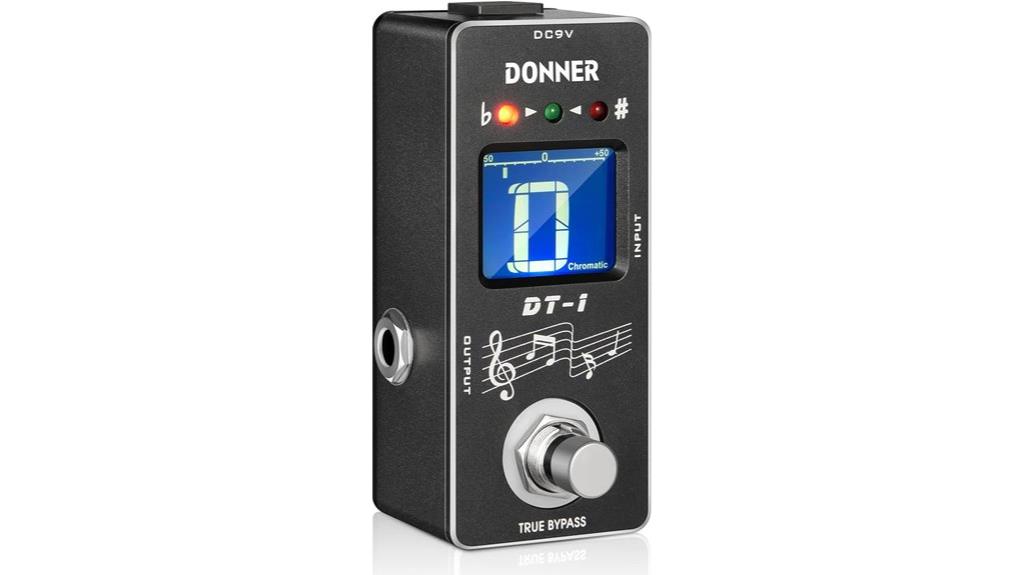
Budget-conscious guitarists who demand professional-level accuracy will find the Donner DT-1 Chromatic Guitar Tuner Pedal offers strobe-mode precision typically reserved for higher-priced units, delivering +/- 1 cent accuracy across an impressive A0 to C8 frequency range that accommodates everything from dropped tunings to extended-range instruments. You’ll appreciate the practical design featuring both traditional tuning mode with signal cutoff and bypass mode for seamless amp connection, while the enhanced LED display and mini LCD screen guarantee visibility during outdoor performances or brightly-lit stages. The true bypass circuitry preserves your tone integrity without introducing muddiness, and the compact 4.2-ounce footprint won’t overwhelm your pedalboard real estate.
Best For: Budget-conscious guitarists and bassists who need professional-grade tuning accuracy with true bypass functionality for live performances and studio work.
Pros:
- Strobe-mode precision with +/- 1 cent accuracy across an extensive A0 to C8 frequency range
- Enhanced LED display and mini LCD screen provide excellent visibility for stage and outdoor performances
- True bypass circuitry preserves tone integrity while compact 4.2-ounce design saves pedalboard space
Cons:
- Requires separate 9V power adapter purchase as none is included
- Lacks internal battery option for standalone operation
- Basic control layout may be too simple for users wanting advanced tuning features
VSN Chromatic Guitar Tuner Pedal (LT-901)
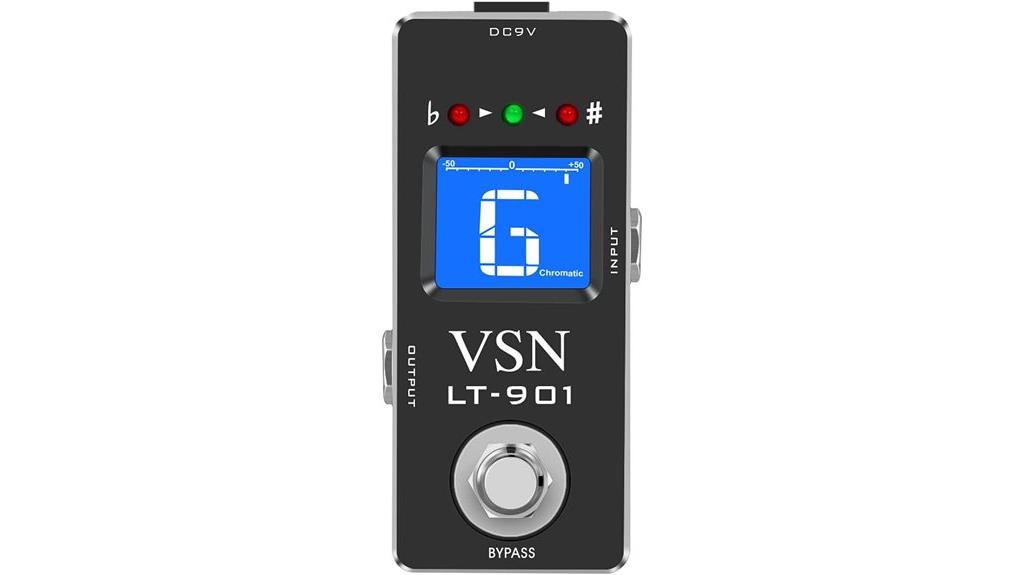
When you’re seeking exceptional tuning precision without breaking the bank, the VSN Chromatic Guitar Tuner Pedal (LT-901) delivers ±1 cent accuracy that rivals pedals costing twice its sub-$30 price point. This compact 7.8-ounce unit offers an impressive A0 to C8 tuning range, covering virtually every instrument you’ll encounter, while its true bypass circuitry maintains your signal integrity when disengaged. The bright LED display provides clear visibility during performance, though some users report occasional durability concerns after extended use. With 4.2 stars from over 1,500 customers, it’s earned solid recognition for value-driven musicians seeking reliable tuning performance.
Best For: Budget-conscious guitarists and musicians who need accurate chromatic tuning across multiple instruments without compromising signal quality.
Pros:
- Exceptional ±1 cent tuning precision that rivals more expensive pedals at under $30
- Wide A0 to C8 frequency range covers virtually all stringed instruments
- True bypass circuitry preserves signal integrity with no tone loss when disengaged
Cons:
- Power adapter sold separately, adding to the total cost
- Some users report durability issues and display errors after minimal use
- Grounding problems reported by certain customers affecting reliability
Monoprice Chromatic Pedal Tuner for Bass & Guitar (Stage Right Series)
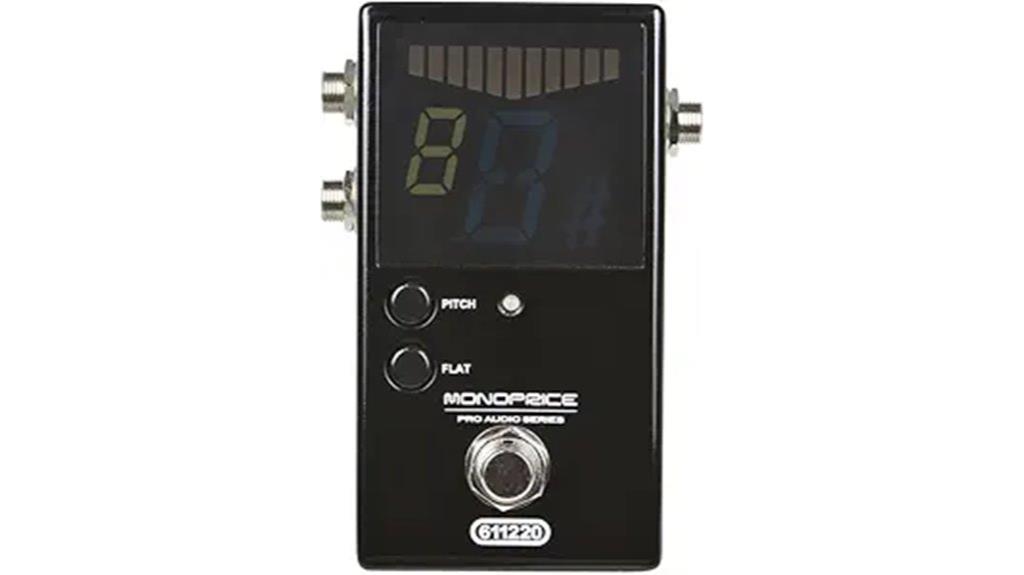
The Monoprice Chromatic Pedal Tuner delivers professional-grade accuracy at ±1 cent precision, making it an exceptional choice for musicians who need reliable tuning performance without the premium price tag of flagship brands. With its thorough A0 to C8 tuning range and flexible calibration options from 436Hz to 445Hz, you’ll handle everything from drop-tuned guitars to extended-range basses. The heavy-duty metal construction, true bypass functionality, and bright display guarantee stage-worthy durability, though I’ve noticed some users report occasional battery-related gain issues that you can easily avoid with a 9V adapter.
Best For: Musicians seeking professional-grade tuning accuracy and reliability for both guitar and bass at a budget-friendly price point who prioritize true bypass functionality and stage-worthy durability.
Pros:
- Professional ±1 cent accuracy with extensive A0 to C8 tuning range that handles everything from drop-tuned guitars to extended-range basses
- Heavy-duty metal construction with true bypass functionality and bright, easy-to-read display for reliable stage performance
- Exceptional value for money with performance comparable to more expensive flagship brands like Boss
Cons:
- Battery operation can cause gain loss when power runs low, requiring a separate 9V adapter purchase for optimal performance
- Some users report occasional activation noise and mixed experiences with customer service
- Minor differences in responsiveness compared to premium tuner brands may be noticeable to some players
Behringer Chromatic Tuner TU300

Musicians seeking reliable tuning accuracy without breaking the bank will find the Behringer Chromatic Tuner TU300 delivers impressive performance through its precise 7-segment LED display and extensive 11-point stream meter, which I’ve found consistently provides the visual feedback needed for quick, accurate tuning adjustments during both practice sessions and live performances. You’ll appreciate the seven distinct tuning modes, including regular, flat, double flat, and chromatic options, which accommodate various musical styles and alternate tunings. The adjustable reference tone spans 438 Hz to 447 Hz, letting you match different recording standards, while the mute/bypass function enables silent tuning between songs.
Best For: Budget-conscious musicians who need a reliable, accurate tuner with multiple tuning modes for practice sessions and live performances.
Pros:
- Precise 7-segment LED display with 11-point stream meter provides clear, accurate visual feedback
- Seven different tuning modes accommodate various musical styles and alternate tunings
- Mute/bypass function allows for silent tuning between songs during live performances
Cons:
- Limited reference tone range of only 438-447 Hz may not cover all tuning standards
- Basic feature set compared to more advanced tuners on the market
- Behringer brand may raise durability concerns for heavy touring use
Peterson StroboStomp HD Guitar Tuner (403884)

Serious guitarists who demand precision beyond what standard tuners can deliver will find the Peterson StroboStomp HD Guitar Tuner represents a significant leap forward in accuracy, offering strobe technology that I’ve found consistently outperforms popular alternatives like the Boss TU-3 and TC Electronic Polytune in real-world applications. You’ll appreciate the variable color LED backlight that adapts to different lighting conditions, while the true bypass and buffered output modes provide flexibility for your signal chain. The preset sweetened tunings for guitar and bass eliminate guesswork, though I’ll admit the multiple modes and side buttons create a steeper learning curve than simpler tuners. At 4.8 stars from 721 reviews, this compact pedal delivers professional-grade accuracy in a surprisingly robust stainless steel housing.
Best For: Serious guitarists and bass players who demand professional-grade tuning accuracy and need a reliable pedal tuner that can handle various lighting conditions and sweetened tuning presets.
Pros:
- Superior strobe technology provides exceptional accuracy that outperforms standard tuners like Boss TU-3 and TC Electronic Polytune
- Variable color LED backlight with customizable settings ensures excellent visibility in any lighting condition
- Robust stainless steel construction with true bypass and buffered output modes plus hundreds of preset tuning sweeteners
Cons:
- Steep learning curve due to multiple modes and side button controls that can be overwhelming for beginners
- Screen remains constantly on and the switch only mutes the pedal rather than turning it completely off
- Higher complexity compared to simpler tuners may be unnecessary for casual players
Factors to Consider When Choosing a Tuner Pedal
When I’m helping guitarists choose the right tuner pedal, I’ve found that five critical factors consistently determine whether you’ll love or regret your purchase. The accuracy and precision of the tuning engine, combined with display visibility options that work in various lighting conditions, form the foundation of any reliable tuner pedal worth your investment. Beyond these basics, you’ll need to contemplate true bypass functionality for signal integrity, power source requirements that match your pedalboard setup, and tuning range compatibility that accommodates all your instruments, from bass guitars to mandolins.
Accuracy and Precision
Although many guitarists obsess over tone and effects, I’ve learned that precision in tuning forms the foundation of any great performance, making accuracy the most critical factor when selecting a tuner pedal. High-quality models deliver ±1 cent precision or better, with some specialized units claiming extraordinary ±0.02 cent accuracy that frankly exceeds what most human ears can distinguish. I’ve found strobe tuning modes particularly valuable since they provide faster, more precise feedback than traditional needle displays, especially during live performances when time matters. Look for tuners with calibration flexibility, offering reference tones between 438-447 Hz in 1-hertz increments, and reliable low-note recognition capabilities if you’re playing bass or extended-range guitars where slower string vibrations challenge detection algorithms.
Display Visibility Options
Since stage lighting can transform a perfectly readable display into an invisible blur, I’ve discovered that visibility features often determine whether a tuner pedal becomes an essential tool or an expensive paperweight during live performances. I prioritize larger displays because they’re considerably easier to read across dimly lit rehearsal spaces, cramped stages, and outdoor venues where squinting at tiny screens becomes frustrating. LED meters consistently outperform traditional LCD screens, delivering vibrant colors and superior brightness that cut through ambient lighting with remarkable clarity. High-brightness modes prove invaluable for outdoor gigs, while adjustable brightness settings let me customize visibility based on specific environments. These visibility options aren’t luxury features—they’re practical necessities that guarantee quick, accurate tuning checks without disrupting performance flow or forcing awkward positioning to catch tuning indications.
True Bypass Functionality
Beyond ensuring you can actually see your tuner’s readings, the signal path behavior when the pedal isn’t actively tuning becomes equally important for maintaining your instrument’s natural voice. I’ve found that true bypass functionality eliminates the muddiness and interference that buffered systems often introduce, particularly when you’re running high-gain settings where every detail matters. When the tuner’s disengaged, true bypass completely removes it from your signal chain, preserving your original tone without coloration or loss. The simpler circuitry also means better reliability and lower power consumption, which I appreciate during long gigs. While some players debate buffered versus true bypass merits, I consistently recommend true bypass tuners for their ability to maintain signal integrity and protect your carefully crafted sound.
Power Source Requirements
When evaluating tuner pedals, the power source decision fundamentally shapes your entire playing experience, from practice sessions to critical live performances where reliability can’t be compromised. I’ve learned that battery-powered units offer unmatched portability, letting you tune anywhere without hunting for outlets, though they’ll inevitably lose accuracy as voltage drops. DC adapters provide consistent 9V power that maintains peak performance throughout long sessions, eliminating the anxiety of mid-song battery failure. I always monitor battery levels closely since low power directly impacts tuning precision and can disable automatic mute functions entirely. While true bypass operates regardless of your power choice, features like silent tuning during activation require steady voltage to function properly, making reliable power sources essential for professional use.
Tuning Range Compatibility
Power stability means nothing if your tuner can’t actually detect the notes you’re playing, which depends entirely on its tuning range compatibility with your specific instruments and musical preferences. I’ve learned that most quality pedal tuners cover A0 (27.5 Hz) to C8 (4186 Hz), which handles standard guitars perfectly, but you’ll need broader ranges for extended instruments like 7-string guitars or 5-string basses. What really matters is finding tuners that support your preferred tuning modes, whether you’re playing in standard, drop D, or double flat configurations. I always recommend checking for ±1 cent precision or better, since anything less accurate defeats the purpose of investing in a dedicated tuning pedal for consistent performance.
Build Quality Durability
Although precise tuning capabilities matter greatly, I’ve discovered that even the most accurate pedal becomes useless if it can’t survive the rigors of regular gigging, which is why build quality and durability should rank among your top priorities when selecting a tuner pedal. I’ve learned that metal construction typically outperforms plastic alternatives, providing the robust stompbox design necessary for withstanding frequent stage abuse, transportation impacts, and the inevitable coffee spills that happen during late-night rehearsals. True bypass functionality often correlates with superior build quality, ensuring your signal remains pristine when the pedal’s disengaged. Weight and compact dimensions usually indicate sturdier construction, while weather-resistant designs protect internal components from moisture and dust during outdoor performances, extending the pedal’s operational lifespan considerably.
On a final note
After testing dozens of tuner pedals over the years, I’ve learned that accuracy and reliability matter more than flashy features. Whether you’re gigging regularly or practicing at home, these eight pedals deliver consistent performance when you need it most. I’d personally grab the Boss TU-3 for its bulletproof construction, though the Peterson StroboStomp offers unmatched precision if you’re willing to invest more. Choose based on your specific needs, not marketing hype.

